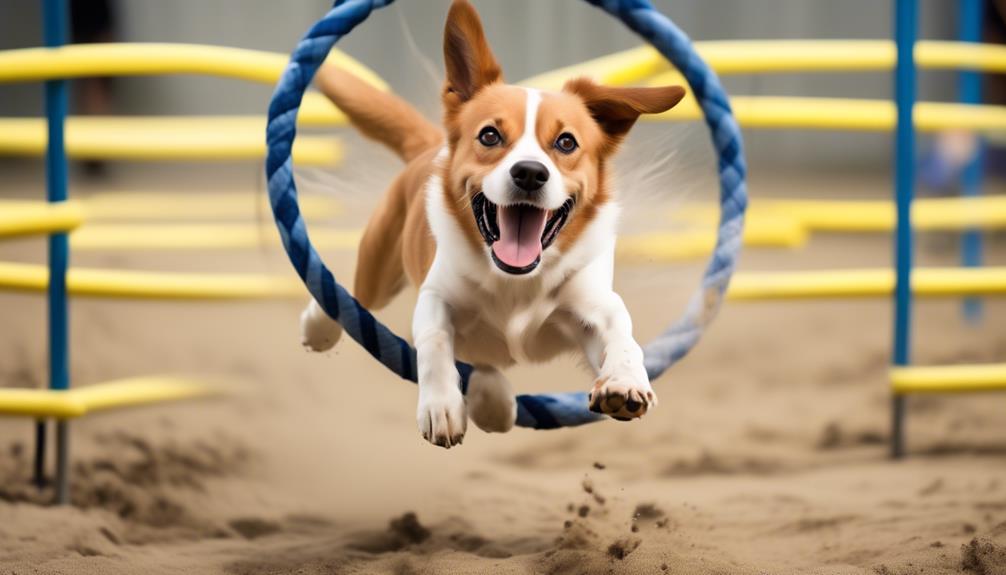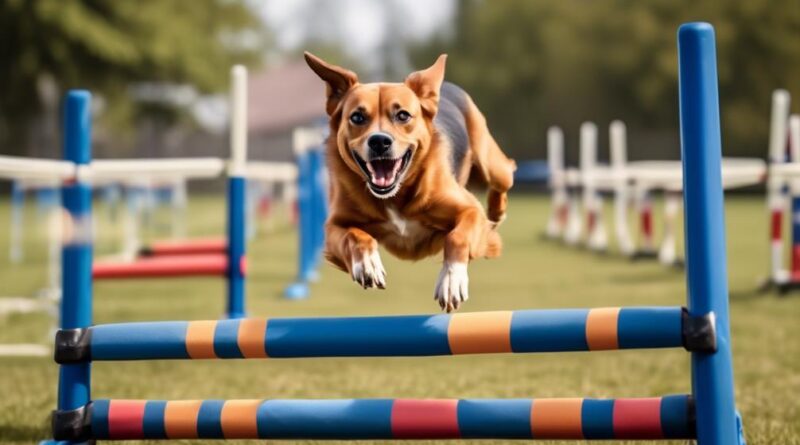Boost Your Canine Athlete's Performance With Agility Training Exercises
Tired of the same old dog walks around the block? Maybe it's time to take your canine companion's fitness to the next level. Agility training exercises can be the key to unlocking your dog's full athletic potential.
From improving speed and endurance to enhancing mental focus and coordination, agility training offers a wide range of benefits for your furry athlete.
But where do you start and how do you progress? Let's explore the world of agility training and discover how it can take your dog's performance to new heights.
Benefits of Agility Training
Engaging in agility training provides numerous benefits for your canine athlete, including improved coordination, mental stimulation, and bond strengthening between you and your furry companion.
Agility training enhances your dog's overall performance by boosting their coordination and physical abilities. By navigating through obstacle courses, your dog learns to maneuver their body with precision, resulting in improved performance in various activities.
Additionally, agility training provides mental stimulation as your dog learns to problem-solve and make quick decisions while navigating through the course. This mental exercise is essential for keeping your dog's mind sharp and agile.
Furthermore, agility training fosters an enhanced bond between you and your dog. As you work together to conquer the obstacles, you and your furry friend develop a deeper level of trust and communication. The training process requires teamwork, with you guiding your dog through the course and providing encouragement and rewards along the way.
This mutual cooperation strengthens the bond and builds a sense of unity between you and your canine companion. The shared experience of agility training creates a unique opportunity for you to connect with your dog on a deeper level, ultimately strengthening your relationship.
Basic Obstacle Training
To begin basic obstacle training for your canine athlete, start with simple and easily accessible obstacles in a familiar environment. When introducing your dog to basic obstacles, such as tunnels, jumps, and weave poles, it's important to create a positive and encouraging atmosphere. Here are some key points to keep in mind during your dog's obstacle training:
- Obstacle handling: Use positive reinforcement and encouragement to guide your dog through each obstacle. Your body language and vocal cues play a crucial role in helping your dog understand what's expected of them.
- Handler communication: Clear communication between you and your dog is essential. Use consistent commands and signals to direct your dog through the obstacles. This will help build trust and understanding between you and your canine athlete.
- Patience and consistency: Remember that learning takes time. Be patient with your dog as they navigate the obstacles and stay consistent with your training methods. Celebrate small victories and progress.
- Bonding and teamwork: Obstacle training isn't just about physical exercise; it's also an opportunity to strengthen the bond between you and your dog. Enjoy the process and celebrate achievements together.
- Safety first: Prioritize safety during training sessions. Ensure that the obstacles are set up correctly and that your dog is comfortable and confident when navigating them.
Advanced Obstacle Courses
When advancing to more complex obstacle courses, focus on refining your dog's agility skills and enhancing their performance through targeted training exercises. Equipment requirements for advanced courses may include adjustable and interchangeable obstacles to cater to various skill levels. Course design becomes more intricate, incorporating challenging elements such as weave poles, A-frames, and tunnels arranged in complex patterns to test your dog's agility and obedience. It's essential to introduce these elements gradually, ensuring your dog is comfortable and confident with each new challenge.
Handling techniques become more crucial in advanced courses, requiring precise communication and coordination between you and your dog. Practice different handling maneuvers to navigate your dog through the course efficiently, using cues and body language to guide them through intricate sequences. Additionally, incorporate speed and accuracy into your training sessions, simulating the intensity of competition environments.
Competition strategy is a key component of advanced obstacle courses. Familiarize yourself with the rules and scoring criteria for various agility competitions, and tailor your training to meet those specific requirements. Emphasize consistency and precision in your dog's performance, while also nurturing their natural athleticism and enthusiasm.
As you progress, seek feedback from experienced competitors and trainers to fine-tune your approach and optimize your dog's performance in advanced agility competitions.
Speed and Endurance Drills
Improving your dog's speed and endurance is essential for enhancing their performance in advanced agility courses. To achieve this, incorporating speed and endurance drills into your canine athlete's training regimen is crucial. Here are some effective drills to boost your dog's speed and endurance:
- Agility ladder: Introduce your dog to an agility ladder to enhance their footwork, speed, and coordination. This drill involves the dog maneuvering through the rungs of the ladder, improving their ability to navigate tight spaces with speed and precision.
- Plyometric jumps: Engage your dog in plyometric jumps to build explosive power and endurance. By performing repetitive, high-intensity jumps, your dog will develop the leg strength and stamina necessary to sprint through agility courses and conquer challenging obstacles.
- Interval training: Incorporate interval training sessions to improve your dog's speed and endurance. Alternating between short bursts of high-intensity activity and periods of rest will enhance your dog's cardiovascular capacity and overall athletic performance.
- Hill sprints: Take your dog for hill sprints to build leg strength and endurance. Running uphill challenges your dog's muscles and cardiovascular system, leading to improved speed and stamina on flat agility courses.
- Water exercises: Consider water-based exercises to boost your dog's speed and endurance. Swimming or walking in water provides a low-impact yet effective way to build muscle strength and cardiovascular endurance.
Implementing these speed and endurance drills will elevate your dog's performance, allowing them to excel in advanced agility courses.
Coordination and Balance Exercises
Enhance your dog's agility and athletic performance by incorporating coordination and balance exercises into their training regimen. These exercises are crucial for improving your canine athlete's overall performance, as they help develop balance and strength, which are essential for navigating agility courses and performing at their best.
To improve your dog's coordination and balance, incorporate agility drills and techniques that focus on these specific areas. One effective exercise is the balance beam, which involves teaching your dog to walk across a narrow beam. This helps them improve their proprioception and balance, which are essential for maneuvering through agility obstacles with precision.
Another beneficial exercise is the wobble board, which requires your dog to stand on a board that tilts in different directions, challenging their balance and stability.
In addition to specific equipment, you can also incorporate balance and coordination exercises into your dog's daily routine. Simple activities such as walking on uneven surfaces like rocks and sand can help improve your dog's proprioception and strengthen their stabilizing muscles. Furthermore, teaching your dog to jump over obstacles of varying heights can also enhance their coordination and balance while building strength in their hindquarters.
Mental Focus Development
To develop your canine athlete's mental focus, incorporate challenging tasks and distractions into their training routine. By introducing these elements, you can significantly enhance their focus improvement and cognitive enhancement. Here are some effective strategies to help your canine athlete sharpen their mental focus:
- Use varying environments: Train your dog in different locations to help them adapt and remain focused regardless of the surroundings.
- Incorporate obedience commands: Integrate obedience commands into their training sessions to encourage mental discipline and focus.
- Utilize interactive toys: Engage your dog with interactive toys during training to test and improve their problem-solving skills while maintaining focus.
- Practice controlled distractions: Gradually introduce controlled distractions, such as other dogs or noises, to teach your canine athlete to concentrate amidst external stimuli.
- Implement time-restricted tasks: Set time limits for tasks to encourage quick decision-making and sustained concentration.
Cross-Training Techniques

Incorporate cross-training techniques into your canine athlete's regimen to diversify their physical conditioning and prevent overuse injuries.
Strength training is an essential component of cross-training for canine athletes. Incorporating exercises like squats, lunges, and core strengthening activities can help improve your dog's overall strength and stability, which are crucial for agility performance. Additionally, strength training can aid in preventing common injuries such as ligament strains and muscle pulls by providing better support to the joints and muscles.
Flexibility exercises are equally important in a cross-training program for your canine athlete. Activities such as stretching, yoga, and balance exercises can help improve your dog's flexibility, range of motion, and muscle coordination. These exercises can also contribute to injury prevention by ensuring that your dog's muscles and tendons stay supple and resilient, allowing them to move more freely and smoothly through agility courses.
Safety and Injury Prevention
To ensure the safety of your canine athlete and prevent injuries, focus on incorporating safety measures and injury prevention techniques into their training regimen.
When it comes to injury prevention, there are several key factors to consider:
- Proper Warm-Up and Cool Down: Always start and end each training session with a proper warm-up and cool down to prepare your canine athlete's muscles and joints for exercise and reduce the risk of injury.
- Appropriate Training Equipment: Invest in high-quality training equipment such as non-slip agility mats, properly sized and fitted harnesses, and supportive footwear to provide stability and protection during training sessions.
- Gradual Progression: Avoid overtraining by gradually increasing the intensity and duration of workouts to allow your dog's body to adapt and strengthen over time, reducing the risk of overuse injuries.
- Consistent Veterinary Check-Ups: Regular veterinary check-ups are essential to monitor your dog's overall health and address any potential issues before they develop into serious injuries.
- Nutrition and Hydration: Ensure your canine athlete maintains a balanced diet and stays properly hydrated to support muscle recovery and overall well-being, reducing the risk of fatigue-related injuries.
Frequently Asked Questions
Can Agility Training Help My Dog Overcome Fear or Anxiety in Unfamiliar Environments?
Yes, agility training can help build your dog's confidence and reduce anxiety in unfamiliar environments. The exercises and positive reinforcement in training can improve your dog's ability to adapt and feel more secure.
What Are Some Common Mistakes to Avoid When Setting up an At-Home Agility Course?
When setting up an at-home agility course, common mistakes to avoid include overlooking safety precautions, neglecting equipment maintenance, and failing to track training progress. By addressing these, you can ensure a safe and effective environment for your dog.
How Can I Incorporate Agility Training Into My Dog's Daily Routine Without Overexerting Them?
To incorporate agility training into your dog's daily routine without overexerting them, be consistent in practice and use rewards for motivation. Start with short sessions and gradually increase difficulty. Consistency and positive reinforcement will help your dog enjoy the training.
Are There Specific Dietary or Nutritional Recommendations for Dogs Involved in Agility Training?
For dogs involved in agility training, consider dietary modifications and exercise supplements to support their performance. Consult a veterinarian to ensure their nutritional needs are met. Balance is key to maintaining their energy levels and overall health.
What Are Some Signs That My Dog May Be Experiencing Physical or Mental Strain From Agility Training, and How Can I Address Them?
If your dog starts showing signs of physical or mental strain from agility training, pay attention to their body language and behavior. Implement relaxation techniques like massage and mental stimulation activities to help them cope with the stress.
Conclusion
So, if you want to take your canine athlete's performance to the next level, agility training is the way to go.
With a combination of basic and advanced obstacle courses, speed and endurance drills, coordination and balance exercises, mental focus development, cross-training techniques, and safety measures, your furry friend will be in top form.
So, get out there and start working on agility training with your dog today!
